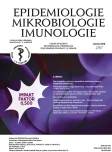Updated Czech guidelines for the laboratory diagnosis of Clostridium difficile infections
Authors:
M. Krůtová; O. Nyč
Authors‘ workplace:
Ústav lékařské mikrobiologie, Univerzita Karlova, 2. lékařská fakulta a Fakultní nemocnice v Motole, Praha
Published in:
Epidemiol. Mikrobiol. Imunol. 67, 2018, č. 2, s. 92-95
Category:
Short Communication
Overview
Clostridium difficile, a causative agent of intestinal infections (CDI) of varying severity, is an important nosocomial pathogen. Microbiological diagnosis, including an appropriate test algorithm and the corresponding interpretation of the results, is crucial for CDI confirmation. This update is based on the European guidance document for CDI laboratory diagnosis, taking into account the current CDI epidemiology and laboratory diagnostic approaches in the Czech Republic.
Any diarrhoeal patient should be tested for CDI. The rectal swabs can only be used for testing in patients with paralytic ileus. Currently, a two-step test algorithm is recommended for CDI diagnosis. Due to a low positive predictive value, a single commercial test is not recommended as a stand-alone test for diagnosing CDI. Samples with a positive screening test (glutamate dehydrogenase or toxigenic strain nucleic acid) and a subsequent negative EIA (enzyme immunoassay) test for the presence of free toxins are diagnostically inconclusive. An option is to use a third confirmatory test; however, the current clinical status of the patient along with other laboratory findings should be considered in order to differentiate between ongoing CDI, carriage of a toxigenic strain of C. difficile, and other causes of diarrhoea.
In general, when implementing a new diagnostic test, its sensitivity and specificity should be compared against the reference method. Diagnostic tests should refer to the data from published comparative studies and should not rely solely on information provided by the manufacturer. Currently, there is no commercial test available for detection of free C. difficile toxins in stool samples with 100 % sensitivity. Moreover, the pre-analytical conditions (storage and transport temperature of stool samples) and/or the initiation of an empirical therapy prior to the sampling may decrease the sensitivity of the assay.
Keywords:
Clostridium difficile – laboratory diagnosis – laboratory testing algorithm – result interpretation
Sources
1. Freeman J, Bauer MP, Baines SD, Corver J, et al. The changing epidemiology of Clostridium difficile infections. Clin Microbiol Rev, 2010;23(3):529–549.
2. Bauer MP, Notermans DW, van Benthem BH, Brazier JS, et al. Clostridium difficile infection in Europe: a hospital-based survey. Lancet, 2011;377(9759):63–73.
3. Davies KA, Longshaw CM, Davis GL, Bouza E, et al. Underdiagnosis of Clostridium difficile across Europe: the European, multicentre, prospective, biannual, point-prevalence study of Clostridium difficile infection in hospitalised patients with diarrhoea (EUCLID). Lancet Infect Dis, 2014;14(12):1208–1219.
4. Krutova M, Matejkova J, Kuijper EJ, Drevinek P, et al. Clostridium difficile PCR ribotypes 001 and 176 – the common denominator of C. difficile infection epidemiology in the Czech Republic, 2014. Euro Surveill, 2016;21(29).
5. Krutova M, Matejkova J, Drevinek P, Kuijper EJ, et al. Increasing incidence of Clostridium difficile ribotype 001 associated with severe course of the infection and previous fluoroquinolone use in the Czech Republic, 2015. Eur J Clin Microbiol Infect Dis, 2017;36(11):2251–2258.
6. Krůtová M, Nyč O. Diagnostika infekcí vyvolaných Clostridium difficile v České republice – dostupnost, možnosti, interpretace laboratorních nálezů. Epidemiol Mikrobiol Imunol, 2015;64(2):92–97.
7. Crobach MJ, Dekkers OM, Wilcox MH, Kuijper EJ. European Society of Clinical Microbiology and Infectious Diseases (ESCMID): data review and recommendations for diagnosing Clostridium difficile infection (CDI). Clin Microbiol Infect, 2009;15(12):1053–1066.
8. Crobach MJ, Planche T, Eckert C, Barbut F, et al. European Society of Clinical Microbiology and Infectious Diseases: update of the diagnostic guidance document for Clostridium difficile infection. Clin Microbiol Infect, 2016;22(Suppl 4):S63–81.
9. European Centre for Disease Prevention and Control. European Surveillance of Clostridium difficile infections. Surveillance protocol version 2.3. Stockholm: ECDC; 2017.
10. Bryant K, McDonald LC. Clostridium difficile infections in children. Pediatr Infect Dis J, 2009;28(2):145–146.
11. Carman RJ, Wickham KN, Chen L, Lawrence AM, et al. Glutamate dehydrogenase is highly conserved among Clostridium difficile ribotypes. J Clin Microbiol, 2012;50(4):1425–1426.
12. Bowman RA, Riley TV. Laboratory diagnosis of Clostridium difficile-associated diarrhoea. Eur J Clin Microbiol Infect Dis, 1988;7(4):476–484.
13. Connor MC, Fairley DJ, McKenna JP, Marks NJ, et al. Clostridium difficile Ribotype 023 Lacks the Ability To Hydrolyze Esculin, Leading to False-Negative Results on Chromogenic Agar. J Clin Microbiol, 2016;54(5):1404–1405.
14. Reigadas E, Alcalá L, Marín M, Martín A, et al. C. difficile PCR--ribotype 023 might go undetected when using ChromId C. difficile agar. Anaerobe, 2017;44 : 34–35.
15. Gateau C, Couturier J, Coia J, Barbut F. How to: Diagnose infection caused by Clostridium difficile. Clin Microbiol Infect, 2017; pii:S1198-743X(17)30678-X.
16. Paitan Y, Miller-Roll T, Adler A. Comparative performance study of six commercial molecular assays for rapid detection of toxigenic Clostridium difficile. Clin Microbiol Infect, 2017;23(8):567–572.
17. Krutova M, Nyc O, Matejkova J, Kuijper EJ, et al. The recognition and characterisation of Finnish Clostridium difficile isolates resembling PCR-ribotype 027. J Microbiol Immunol Infect, 2017 May 24.
18. Krutova M, Nyc O, Matejkova J, Allerberger F, et al. Molecular characterisation of Czech Clostridium difficile isolates collected in 2013–2015. Int J Med Microbiol, 2016;306(7):479–485.
19. Freeman J, Wilcox MH. The effects of storage conditions on viability of Clostridium difficile vegetative cells and spores and toxin activity in human faeces. J Clin Pathol, 2003;56(2):126–128.
20. Sunkesula VC, Kundrapu S, Muganda C, Sethi AK, et al. Does empirical Clostridium difficile infection (CDI) therapy result in false-negative CDI diagnostic test results? Clin Infect Dis, 2013;57(4):494–500.
21. Sethi AK, Al-Nassir WN, Nerandzic MM, Bobulsky GS, et al. Persistence of skin contamination and environmental shedding of Clostridium difficile during and after treatment of C. difficile infection. Infect Control Hosp Epidemiol, 2010;31(1):21–27.
Labels
Hygiene and epidemiology Medical virology Clinical microbiologyArticle was published in
Epidemiology, Microbiology, Immunology

2018 Issue 2
Most read in this issue
- Streptococcal toxic shock syndrome – a life-threatening condition caused by various streptococcal species
- Bacteremia due to Staphylococcus aureus – the importance of appropriate management
- Fight against antimicrobial resistance
- Updated Czech guidelines for the laboratory diagnosis of Clostridium difficile infections
